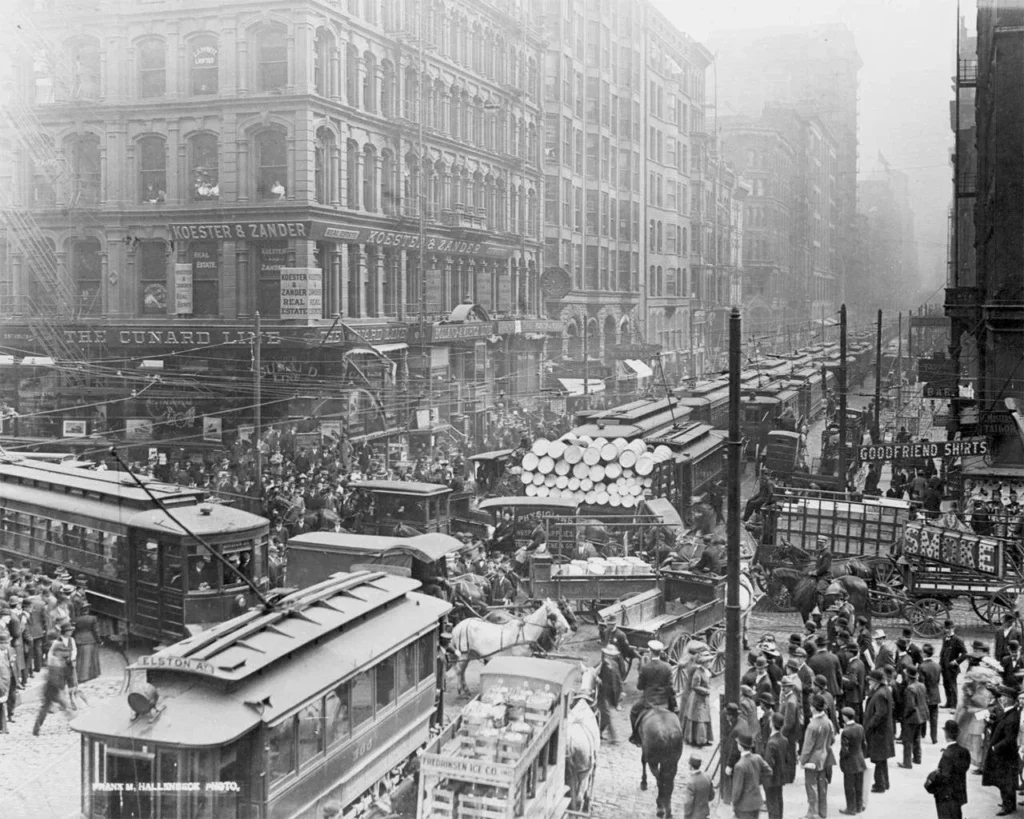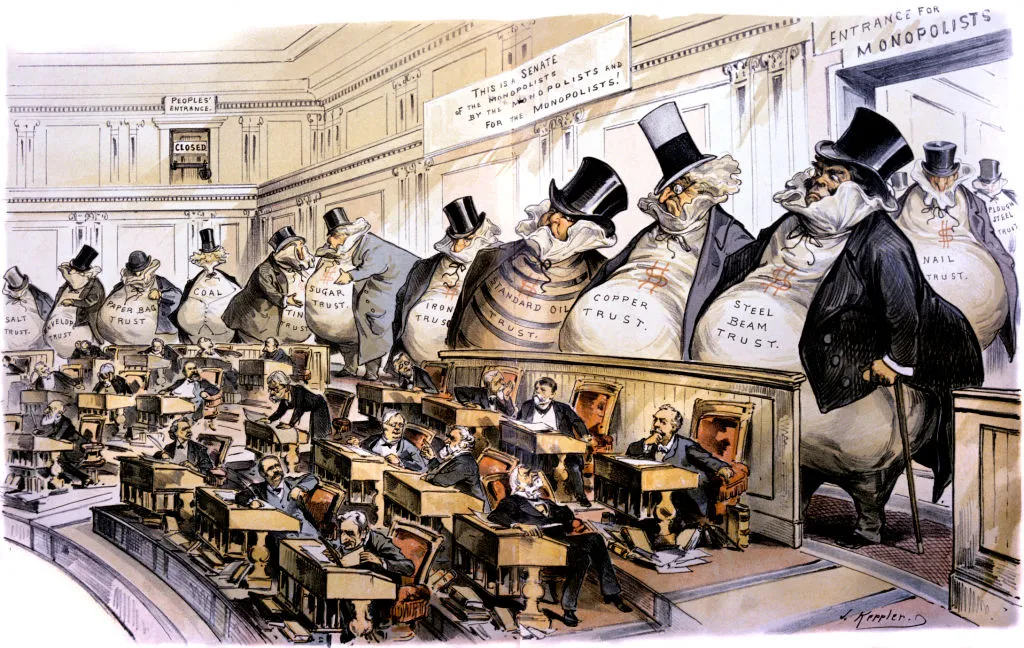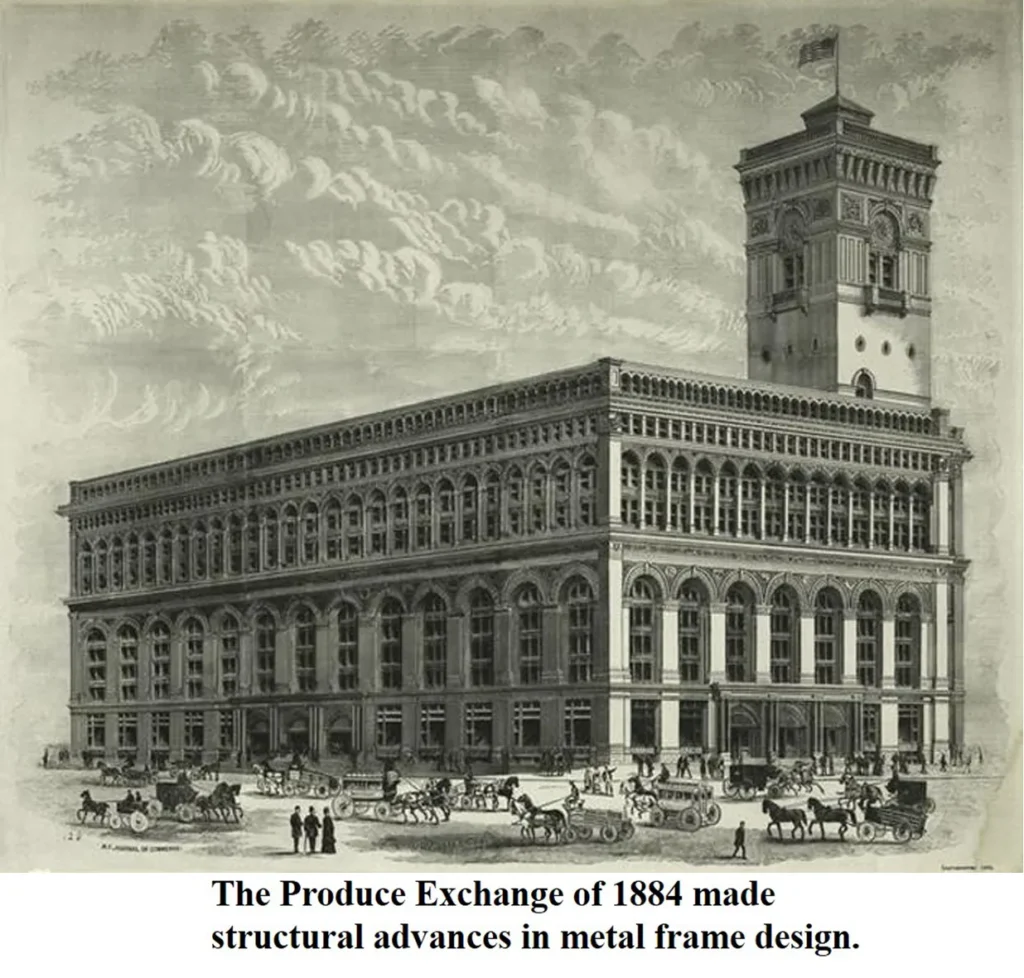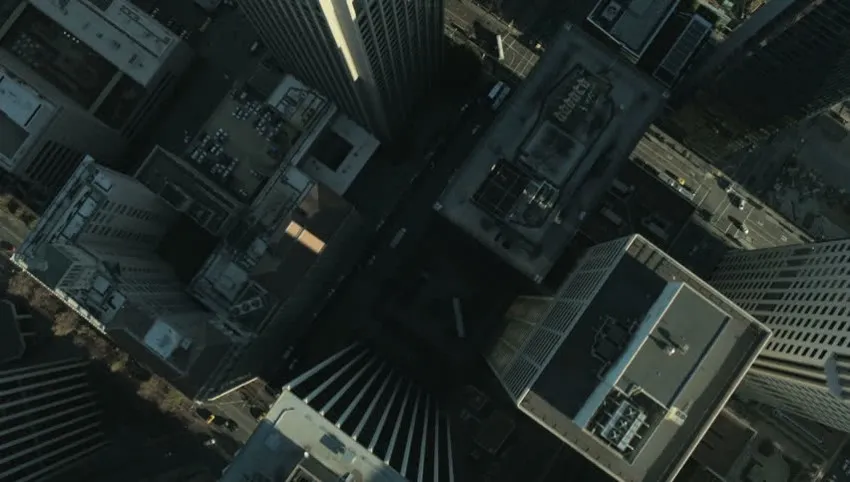If you want to know about the technical challenges for tall building or definition and evolution of tall building or history of tall building, please click the link.
The history of tall buildings dates back to ancient times, when various cultures around the world constructed structures that were taller than their surroundings. Examples include the pyramids of Egypt, the ziggurats of Mesopotamia, and the temples of Central America.
- Industrial growth started in the US since early 1800s and continued steadily up to and through Civil War. (1861 – 1865)
- Industries were still small and dependent mostly on hand labour. Hence, production capacity was limited. Businesses lacked capital needed for expansion.
- After the Civil War the situation changed dramatically. Machines replaced manual work giving a huge push to production capacity.
- These factories encouraged more and more people to move to urban areas where jobs were plentiful, but hourly wages were often low, and the work was routine and grindingly monotonous.
- The following innovations proved critical in shaping urbanization at the turn of the century: electric lighting, communication improvements, intracity transportation, elevators and the rise of skyscrapers.

1) Usa – the background of high-rise development
- Before the mid-1800s, factories, such as the early textile mills, had to be located near rivers and seaports, both for the transport of goods and the necessary waterpower.
- Nationwide network of railways
- Inventors developed products which the consumers wanted. Industrialists manufactured products in large quantities.
- Investors and bankers pumped in large amount of capital to business leaders to expand their business.
- Industrial growth made major impact on American life.
- Record number of people moved to cities and the cities grew in leaps and bounds.
- As people migrated for the new jobs, they often struggled with the absence of basic urban infrastructures, such as better transportation, adequate housing, means of communication, and efficient sources of light and energy.
- Even the basic necessities, such as fresh water and proper sanitation—often taken for granted in the countryside—presented a greater challenge in urban life.

- Congestion, pollution, crime, and disease were prevalent problems in all urban centers; city planners and inhabitants alike sought new solutions to the problems caused by rapid urban growth. Living conditions for most working-class urban dwellers were atrocious.
- They lived in crowded tenement houses and cramped apartments with terrible ventilation and substandard plumbing and sanitation.
- As a result, disease ran rampant, with typhoid and cholera common. Memphis, Tennessee, experienced waves of cholera (1873) followed by yellow fever (1878 and 1879) that resulted in the loss of over ten thousand lives.
- By the late 1880s, New York City, Baltimore, Chicago, and New Orleans had all introduced sewage pumping systems to provide efficient waste management. Many cities were also serious fire hazards.
- An average working-class family of six, with two adults and four children, had at best a two-bedroom tenement. By one 1900 estimate, in the New York City borough of Manhattan alone, there were nearly fifty thousand tenement houses.

- The Democrats and Republicans (also called the Grand Old Party, GOP) fought over control of offices, which were the rewards for party activists, as well as over major economic issues.
- The major metropolitan centres underwent rapid population growth and as a result had many lucrative contracts and jobs to award.
- To take advantage of the new economic opportunity, both parties built so-called “political machines” to manage elections, to reward supporters and to pay off potential opponents.
- Financed by the “spoils system”, the winning party distributed most local, state and national government jobs, and many government contracts, to its loyal supporters.
2) The politics

3) The skyscraper story begins…
- Significant economic growth after the Civil War and increasingly intensive use of urban land encouraged the development of taller buildings beginning in the 1870s.
- Chicago initially led the way in skyscraper design, with many constructed in the centre of the financial district during the late 1880s and early 1890s.
- Sometimes termed the products of the Chicago school of architecture, these skyscrapers attempted to balance aesthetic concerns with practical commercial design, producing large, square palazzo-styled buildings hosting shops and restaurants on the ground level and containing rentable offices on the upper floors.
- Chicago became the railroad hub for the American West and the primary trading city for the emerging territories, famous for its commercial culture.
- Chicago, after great fire, was rebuilt on large plots of land in a new grid network, and followed new city ordinances that prohibited construction in wood.
- Traditional buildings supported their internal floors through their walls, but the taller the building, the thicker the walls had to become, particularly at the base: buildings of any substantial height rapidly saw their lower floors eaten up by brick or masonry.


4) How they resolved the problem of height
- French engineers had made advances in Fire Proofing in the early 19th century, but major breakthroughs only came with the work of architect Peter Wight in the 1860s.
- Ground water was a problem because increased height meant deeper foundation. The deeper the foundations needed to be, the greater the challenge.
- Special water-tight boxes called caissons were invented to deal with this problem in England in 1830 and adopted in the US during the 1850s and 1860s.
- Elevators using hoist ropes, however, could only function effectively in low-rise buildings and this limitation encouraged the introduction of the hydraulic elevator in 1870, even though early models contained dangerous design flaws.
- By 1876 these problems had been resolved, providing a solution for servicing the early skyscrapers.
- Now, about ventilation: in the 1850s, a system using low-pressure steam and steam-operated fans came up. These were adopted in the construction of the later skyscrapers
- Improvements in iron piping permitted running hot and cold water and sanitation facilities to be installed throughout taller buildings for the first time.
5) Socio-psychological factors
- Tall buildings fit in well where business and organizational structures are geared to large-quantity operations; where building materials are plentiful; and where there is an adequate force of skilled labour.
- The economic viability of building tall is ultimately a matter of location and local conditions. It can be the lowest-cost solution in a developed country in a location with other high-rises where the needed infrastructure and urban services are in place
- The impact of tall buildings on property values varies. In some places, because of newly generated traffic and crowding, property values in nearby neighbourhoods may diminish.
6) Inadequacies……..
- While the benefits of high-rise buildings are generally considerable—such as proximity to services and public transportation, efficient use of land and infrastructure—some inadequacies are there; these include:
Density and land use
- Higher construction is not necessarily equivalent to higher residential densities.
Economics
- Initial costs, maintenance costs and operation costs are higher proving the high rises out of the economic rage.
- Also, lower construction time for low rise as compared to longer times for tall buildings result in high interest costs.
7) Development control
- If not located and constructed in coordination with comprehensive master plan and development schedule, tall buildings create additional problems of urban infrastructure.
- Tall buildings give limited balconies and surrounding open spaces are converted for public use creating dissatisfaction for people demanding sizable open private spaces.
Transportation
- If provision is not made in the master plan or existing development does not allow for expansion, large amount of traffic generated by tall buildings can overtax public transportation systems and create extensive automobile traffic.
Services
- High domestic water consumption,
- Wastage of usable floor area in services like lifts etc.
- Fear of soil subsidence due to overloading etc.
8) Urban environment
- Tall buildings may become objects of visual pollution in urban environment.
- They may generate uncomfortable winds at street level if not appropriately designed and can alter the city’s micro-climate.
- Refuse, increased pollution by automobile traffic can lower the quality of environment in the nearby areas.
- They can be responsible for overshadowing of adjacent buildings
9) Resource and materials
- Tall buildings consume a large amount of building materials, particularly steel & cement and sometimes drain these resources away from the necessary development projects.
- Also higher proportion of skilled labor is required which may have to be brought internationally creating higher local unemployment.
10) Safety
- Due to their size, complexity and interdependence of systems risks of potential danger increases and more secure features have to be designed into the building.
- Crime, vandalism etc are common endangers in high rises.
- Feeling of being away from nature.
- Feeling of being trapped.
- Fears of accidental fall.
- Problems related to medical fitness specially in case of cardiac and asthmatic patients.
11) Aesthetics
- If proper care is not taken in façade design tall buildings can ruin the otherwise pleasing skyline or crate visual barriers for urban residents. They can alter the character of a historic city or devalue a neighboring building area.
12) Energy
- Tall buildings are high consumers of energy in large quantities during construction, operation and maintenance which should be optimally controlled.
13) Construction deficiencies
- Even where plans and specifications are excellent, problems can arise.
- Specified materials are frequently substituted for those which are not compatible in their place of application. Manufacturers’ installation requirements can be short-circuited by trades etc.
- Therefore, from the conceptual stage, a more active role of an integrated project team in ensuring that construction meets the project requirements is essential to improving building performance.
14) Site selection
- The important factors to be remembered before selecting the site for tall buildings are:
- Location– with-respect-to existing structures, transport facilities, approach roads, linking roads etc.
- Geography: Orientation with respect to sun, seismic conditions of the area, density, population growth, land use pattern etc. etc.
- Topography: Study of existing and surrounding site features, vegetation, surfaces etc. and the effect on the microclimate, etc.
15) Location
- Construction of High-rise should be directed to maximize walkability, support the transit system, and enhance the importance of the city’s key activity centers like Station Lands, hospital, university, or college etc.
- High-rise should be developed only if directed by an Area Redevelopment Plan or existing zoning Plan.
- High-rise buildings should be developed as slender towers with small floor plates to reduce shadow and wind impacts, and to protect views.
- High-rise buildings should be sited and designed to establish a focal point or landmark in the area

- Type of soil: Whether rocky, loose, hard etc to adequately design the foundations. Check the bearing capacity of soil for the maximum load to be distributed by the structure.
- Water table: The level of water below the surface needs to be accounted before constructing a high rise as the foundation depths of high rise are deeper than horizontal structures.
- Vehicular accessibility is important; otherwise, there will be traffic congestion and overcrowding.
- Wind conditions: The intensity of wind flow, and their nature (dry, Moisture-laden).
- Orientation: of sun and wind to check the impact of wind loads and other external influences on the tall structure.
- Skyline: The existing skyline should not be hampered, and the proposed structure should be in consonance with the existing skyline.
- Disturbing elements: tall buildings should not be located too close, or in an area consisting of ordinary buildings. This disrupts the hierarchical process of space privacy in quite private places (House) and semi-private places. Accessibility of relief and emergency services, e.g., firefighting facilities to the building is another important factor, therefore:
- Tall buildings should not be located in narrow and blind areas, and high hills.
- It should have sufficient frontage in order to provide enough protection when fire accidents occur in nearby blocks.
- At emergency times, the passages and routes must be so designed that the relief services would have an easy access to the building.

So, facilities given below should be readily available near a Tall building to operate successfully:
- Communication and transportation routes,
- public facilities and infrastructure,
- conservation of natural and environmental resources,
- prediction of the population,
- beautification and development of desirable landscape,
- compatibility of adjacent buildings
16) Site characteristics
- The site should be large enough to provide for adequate building setbacks and a transition / decrease in height to the edges of the site, to achieve compatibility with existing small scale development in the surrounding area.
- The site should be separated from existing small-scale residential development by a major roadway or other non- residential use.
- The site should have a direct access to an arterial road.
- The exterior of high–rise buildings should be finished with high quality materials depending on its effect on the surroundings.
- High-rise buildings should be located and designed to minimize loss of privacy for other residential development in the area.
- High-rise should include small-scale commercial or community uses on the ground floor that meet the daily/weekly needs of local residents.
17) Open spaces and amenities
- High-rise projects should include significant indoor amenity spaces and outdoor open spaces designed for the recreational and social use of residents and users.
- High-rise projects should have a high quality of landscaping on the site, and along adjacent street boulevards or walkways.
- High-rise developments that are part of a large scale redevelopment project, should dedicate additional public park space.
18) Parking
- The majority of parking for the residents of high-rise projects should be provided underground or in above ground structures (parking garages).
- Surface parking for visitors should be developed at the side or rear of the building, and be well landscaped.
- Parking garages should be designed with residential, commercial or community uses at a grade to provide for active frontages.
19) Need & criteria – pressure on land
- There are only a few urban centres in India that promise better prospects than most cities and towns — leading to much more pressure on their infrastructure and housing — and resulting in disordered urbanisation. This is reflected in almost 65.5 million Indians who, according to the country’s 2011 Census, live in urban slums and sprawls.
- Today, Mumbai houses upwards of 21 million residents. It’s one of the densest megacities in the world. Over the last decade, to compensate for a lack of space for the city’s rapidly growing population, and to meet the rising demands of the global real estate market, developers have built more, faster, and taller.